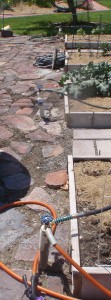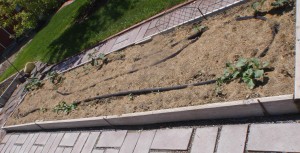Watering is rather like the invisible chore of gardening. I have a tendency of thinking of it as not taking much time. It is also not “done” the same way as other garden activities. With the exception of things like pots, watering doesn’t require constant presence. It does, however, require constant diligence.
I like to use soaker hoses for most of my vegetable garden. I am grateful to have an automatic sprinkler system for the spring days without rain, when tender new plants are getting established. Once they are larger, however, many of them either block the sprinklers or do better with soil level watering.

If you just have a couple of outside faucets, this could be a challenge. There are a few ways to overcome this, some more involved than others:
- My dad has recently come up with a rain barrel to soaker hose system that is a good fit for his average size suburban yard. It doesn’t do all of his watering, but it helps a lot with the vegetable garden and a few flower beds.
- My husband put in an extra line of pipes along my raised beds. He built a two-headed faucet at each garden bed. This makes it so that I can run 8 soaker hoses at once. We have since put in a few more raised beds, but with that many faucets available, I can still get most of the watering done in a day or two on my acre.
- This year, I bought short pieces of hose to attach between the faucet and soaker hoses, so that there is not so much dripping (and weed growth and wasp activity) under the faucet.
- Some of my friends use an above ground system to mimic multiple faucets by building an irrigation network with tubing and directional valves to direct the water from one hose. It is faster and less work on an everyday basis than moving the hose.
- My watering chart still comes in handy, because the memory is a tricky thing…
- Don’t underestimate timers and alarms to help you out.
- Don’t forget that it isn’t too difficult to remake your soaker hoses to the length you want. I find that a 25 foot soaker hose fits and waters a 12 to 16 foot long by 4 foot wide raised bed very well. The 100 foot lengths are harder to uncurl and position, but can be cut up into sections that water smaller areas nicely if you don’t want to use Netafim. I recently installed some Netafim and think it works better for flower gardens than vegetable gardens.
Working around soaker hoses is easy, as long as you remember that one puncture, … say with a hand cultivator … , ruins the whole hose. It is best to get into the habit of just lifting the soaker hose out of the way when working near it like that. Other than that, I find my soaker hoses can last several years and are not subject to the same clogs and hard water deposit blockage as the more detailed drip systems. It has been fine to let them get covered with mulch as long as you remember to locate them when weeding and digging.

I run a check on all of my soaker hoses once a year, in the spring and before planting. I check for major leaks before I plant seeds or transplant seedlings. It is much easier to have soaker hoses in place before the sprouting and growing. Otherwise, I end up with situations like a gusher point unearthing plants at the root zone, or needing to remove them from an impossible tangle of foliage because no water is getting to the second half of the hose. In some cases, especially when this happens mid season, I just leave the broken hose there and place the new one carefully between the plants.
I have never wound up the soaker hoses and stored them over winter. For one thing, they are not easy to wind or unwind. They get stiff with age. Even with letting them lay in the sun a while to soften, they are hard to get to lay straight once I do get the in place. Those irrigation u-stakes are useful, but I have mostly used larger rocks or bricks until they accept their new shape.
When my soaker hoses are ready for the graveyard, my husband often saves a few for the unexpected applications of soaker hose remnants that he will think of in 10 years. But I don’t mind. As long as they are in a distinct place, so that I don’t get confused come spring, he can keep as many inventor supplies on hand as he likes.
Even if all you have right now is a couple of faucets, nothing beats soaker hoses for ease in setting up as a drip irrigation option. It is one piece and the only design is where to lay it. They are nearly invisible once the plants grow.
